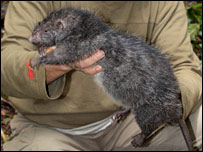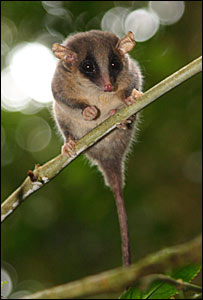 |
A giant rodent five times the size of a common rat has been discovered in the mountainous jungles of New Guinea.
The 1.4kg Mallomys giant rat is one of two species of mammal thought to be new to science documented on an expedition to an area described as a “lost world”.
Conservationists also found a pygmy possum – one of the world’s smallest marsupials – on the trip to the remote north of Papua province, Indonesia.
Both are currently being studied to establish whether they are new species.
Scientists on the trip, organised by Conservation International (CI), also recorded the mating displays of several rare birds for the first time.
“It’s comforting to know that there is a place on Earth so isolated that it remains the absolute realm of wild nature,” said Bruce Beehler, who led the expedition.
Old friends
The trip was the second time that CI had visited the Foja Mountains, part of the Mamberamo Basin, the largest pristine tropical forest in the Asia Pacific region.

Scientists are studying the possum to confirm if it is new to science
|
In 2005, the area was dubbed a “lost world” after scientists discovered dozens of new plants and animals in the dense jungle.
During the most recent trip, in June of this year, scientists accompanied by a film crew managed to capture courtship displays of the golden-fronted bowerbird (Amblyornis flavifrons) and of the black sicklebill bird of paradise (Epimachus fastuosus).
They also recorded the wattled smoky honeyeater (Melipotes carolae), documented for the first time on the 2005 expedition and known only from the Foja Mountains.
The bird, with a bright orange patch on its face, was then the first new bird species to be sighted on the island of New Guinea in more than 60 years.
The team also captured an old friend on film – the “lost” Berlepsch’s six-wired bird of paradise (Parotia berlepschi).
The iridescent gold-breasted bird was “rediscovered” in 2005 by CI experts after 20 years without a confirmed sighting by a western scientist.
However, the most surprising finds of the trip were the two new species of mammal – the Cercarteus pygmy possum and Mallomys giant rat.
“The giant rat is about five times the size of a typical city rat,” said Kristofer Helgen, a scientist with the Smithsonian Institution in Washington, D.C.
“With no fear of humans, it apparently came into the camp several times during the trip.”



